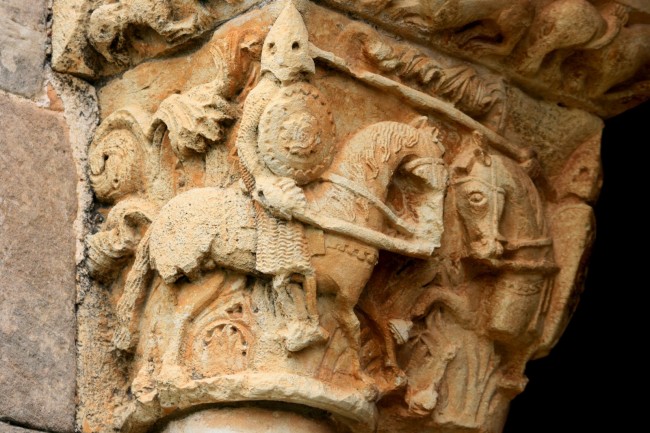
There is another Spain, different from that of the beaches, massive tourism and the beach bar with a rise in prices and a decline in quality. A Spain that combats depopulation, where the landscape is being acceptably kept and its huge heritage is conserved in each of its little villages. Where the unique vestiges of their medieval past have been wisely preserved without relinquishing its development, offering the visitor a wide range of cultural and gastronomic options.
Castilla León is one of the prime tourist destinations in Europe offering a wide diversity.
About half of the great wealth of the Natural and Cultural Heritage of Spain is here. Among which we can find:
- Eight sites declared as World Heritage by UNESCO, two of which are in Burgos: The Cathedral of Santa María la Mayor (Saint Mary the Major) a jewel of Gothic art, and Atapuerca Site, probably Europe’s most important archeological site and one of the best paleonthological sites in the world. The third one, Saint Jacob’s way, crosses the province. It is one of the world’s most important pilgrimage routes and it covered the region in little cultural treasures along the centuries.
- About 1800 sites listed for its cultural interest among its nine provinces in Castilla León. There are 28 cultural assets only in the capital, Burgos, which tell us about the five centuries when it was the capital of the kingdom of Castille and León (from the tenth to the fifteenth centuries).
Among them, noteworthy are: La Cartuja de Miraflores (a monastery), El Arco de Santa María (a gate), Las Huelgas (a monastery) or La Casa del Cordón, where The Catholic Monarchs met Christopher Columbus after his second voyage to America.
But the province wins hands down with its 373 Cultural Property in all the categories.
We have already spoken about some of them in this blog before. Historic monuments hidden in abandoned villages, such as the Church of Villamorón, or shared with other provinces like the Channel of Castille, a spectacular work of civil engineering of the eighteenth century. Historic-artistic settings such as Orbaneja del Castillo or Villadiego itself. Historic sites such as the salines of Poza de la Sal … - There are more than 400 museums, 500 castles and 12 cathedrals in Castille Leon.
- And the biggest concentration of Romaesque art in the world, spread in every little village. Or the Museum of Romanesque art (ROM) located in the vestry of Santa María la Real church in Aguilar de Campoo, 30 minutes away from Villalibado. It not only has a unique exhibition space, which is worth visiting, but also has the best Romanesque Digital library in Spain, for public use, where one can check fact sheets, plans and photographs of all the churches, sorted by provinces and towns.
Although cultural tourism is the main reason to visit the area, there are lots of paths in the 40 natural protected areas in the region to enjoy active tourism. An example is Las Médulas, in León, where you can enjoy an impressive landscape while crossing an open sky gold mine, a feat of civil engineering of the Roman Empire.
But if there is something all the provinces in Castille Leon have in common, that is their high value and quality cuisine, and Burgos’ is no less. In fact it was chosen Spanish Capital of Cuisine in 2013.

Whenever I go on rural holidays to Burgos, I always ask a local where you can eat well. And the answer is usually the same: you can eat well anywhere in Burgos. Suckling roasted lamb in a wood fire oven, sheep cheese, smoked meat, a famous type of black pudding called morcilla – there is a different recipe in each town- and red beans from Ibeas de Juarros, the basic ingredient for the famous and traditional Olla podrida stew.
All this accompanied with the wines of Ribera del Duero – one of Spain’s most famous Designations of Origin.
This is the type of tourism we propose to you.
Villalibado is in a cereal growing area, however it is very close to some places of interest. For example, in about half an hour by car, you can be in El Cañón del Ebro – the river Ebro canyon-, where you can go hiking Valdelateja-Pesquera-Valdelateja. I can assure you the lanscape above the canyon is stunning. Cross Cortiguera with its church and deserted palaces, then have lunch in Pesquera and return by the riverside after a beautiful hike of 4 or 5 hours.
Or you could go as far as Orbaneja del Castillo, definitely worth the visit.
I would also recommend visiting Aguilar de Campoo, about half an hour away, and on the way back, getting to Rebolledo de la Torre with its wonderful Romanesque church and walking by the waterfall of Yeguamea in Fuenteodra, particularly beautiful in spring.
A bit farther down, an hour’s distance, is a captivating route by the river Arlanzón. Do not miss Covarrubias (a Historic-artistic site) and stroll around San Pedro de Arlanza, a derelict monastery and one of the most romantic places I have ever been to.
Later you may visit a ‘sabinar’ –a juniper thicket, listen to the Gregorian chants of the monks in Santo Domingo de Silos or ,just at a 2 kilometres’ distance, cross the pass of Yecla, with less than 300 metres in length.
- Cortiguera
- Rebolledo de la Torre
- Covarrubias
- San Pedro de Arlanza
- San Pedro de Arlanza
- S. Domingo de Silos
- S. Domingo de Silos
- Pass of Yecla
- Pass of Yecla
To sum up, Castille Leon is one of the richest and most varied places in which you can enjoy completely different experiences to those by the beach. Oddly enough, it is one of the most unknown places too.
















No Responses to “Tourism in Burgos and Castilla León: plenty of culture, landscapes and gastronomy.”